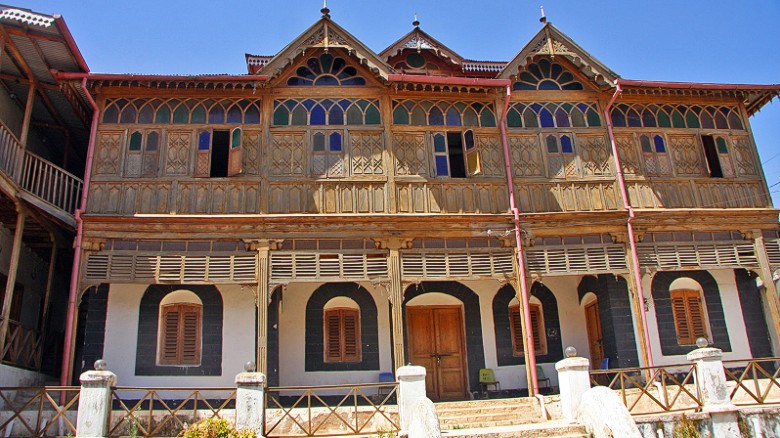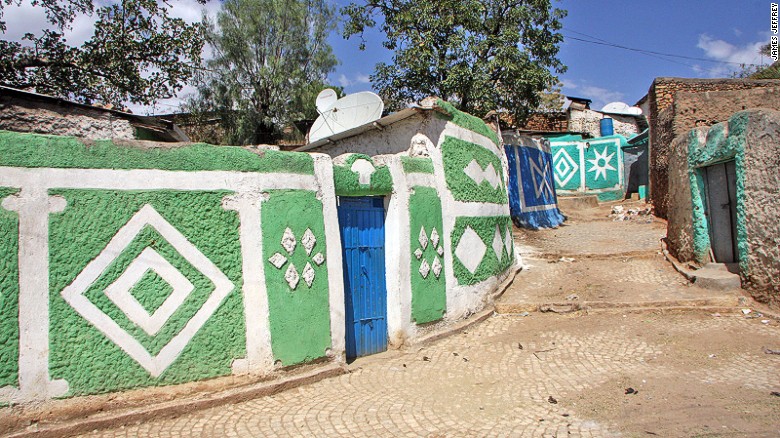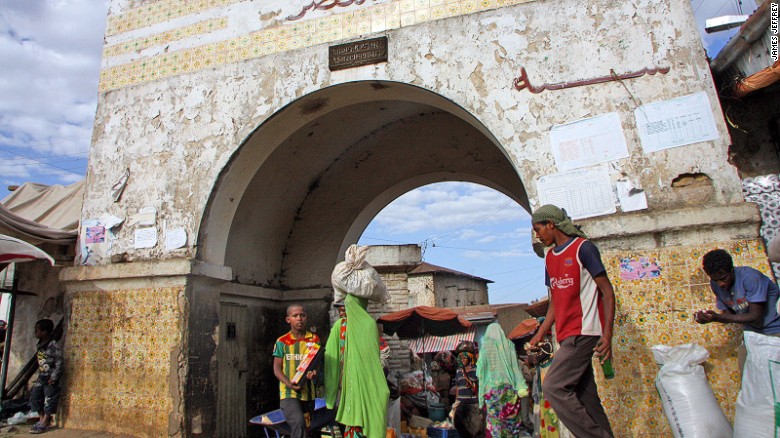(CNN)The
ancient walled city of Harar in eastern Ethiopia is a hard place to
forget: the silent maze-like alleys, the scents of the markets, the
handsome women carrying intricately woven baskets atop heads, the
muezzins calling the Muslim faithful to prayer.
It's remained seared in my consciousness since my first visit in 2004.
I wasn't the only one impressed; the city became a UNESCO World Heritage Site in 2006.
A
decade later, following much development and change in Ethiopia, I was
curious to see if the city still retained its exotic finesse and
character that so affected me before.
So I returned.
From my hotel room's small balcony I could see the Asmaddin Beri (beri means gate, as well as, rather more grandly, portal).
It's
one of six punctuating the thick five-meter-high walls running 3.5
kilometers around the Jugal, the name for the 16th-century fortification
that lies within the modern town that developed from the 19th century
onward.
Once through the Asmaddin
portal the 21st century vanished, replaced by a sense of antiquity and a
heaving, shambolic outdoor market, one of many dotted around the Jugal.
Harari women in colorful dresses squatted beside neat piles of onions, tomatoes, green peppers, bananas and more.
Sweet
smells wafted from where women sold pots of itan (incense), while
samosas cooking on small stoves and baskets full of fresh bread rolls
added to the pleasant stimulation.
"Feranju!
Feranju! Amantekhi?!" the women called in the local Harari dialect,
which roughly translates as: "Foreign guy, foreign guy, how are
things?!"
Maze of alleyways
The simplest way to explore the Jugal is to get lost among the warren of narrow, twisting alleys.
Eventually you stumble upon a main street or landmark.
On
Mekina Girgir, a narrow, atmospheric street packed with tailors'
workshops and men at sewing machines, one tailor looked up from his
machine to point the way to what's known as Arthur Rimbaud's house.
The
French poet, who turned his back on literary stardom and became a
gunrunner in Harar, didn't actually live in the large ornate house
standing today.
This was built by an Indian merchant on the site of an earlier house where Rimbaud apparently lived.
Inside,
on the second floor, a photographic exhibition of
turn-of-the-20th-century Harar shows the strange world Rimbaud
encountered -- some scenes with similarities to the present day.
Despite
the Jugal containing 82 mosques and this being a return trip I couldn't
seem to find any of them as I zigzagged among pastel-colored alleyways
that decorate the walled city's interior.
I enlisted the help of a young scruffy boy passing by who, within 10 minutes, had taken me to three mosques.
At each one he beckoned to where he indicated the best position from which to take a photograph.
He was right every time.
Center of Islamic scholarship
Believed to have been founded by Arabian
immigrants around the 10th century, Harar became a crossroads for trade
and culture, ideally situated between the Ethiopian highlands to the
west and the shores of the Gulf of Aden to the east.
The
city evolved into a center of Islamic scholarship and culture, and
eventually was considered a sort of capital city of Islamic northeast
Africa.
In the 16th-century, Emir Nur
ibn al-wazir Mujahid became Harar's ruler and fortified the city against
the threats of Christian forces from Ethiopia and increasing migration
of the Oromo people.
Foreigners -- especially infidels -- were denied access to the city.
But
in 1855 British explorer Richard Burton ignored the ban and traveled
from the port of Zeila on the Somalian coast to enter the city disguised
as an Arab merchant through Argob Beri in the eastern wall, staying for
10 days.
Nowadays locals are more accepting of those coming from far beyond their walls.
After
a decade of rising tourist numbers, I noticed how more people, children
and adults included, expected to be paid for having their photos taken.
I exhausted my quota of polite rebuttals to the stream of offers from young men offering to act as guides.
Despite
some residents changing their attitudes toward tourists, the general
way of life in the Jugal seemed utterly unchanged from my 2004 visit.
I
still seemed a long way from the international commerce and high-rise
buildings that have emerged in Addis Ababa, Ethiopia's rapidly growing
capital.
Modern world
Oromo women still came from the
surrounding rural areas bringing donkeys laden with firewood to sell and
then spend their earnings in the Jugal's markets on food and household
goods.
Sharp-eyed kites still circled
around the Gidir Magala market and the city's main butchery, ready to
swoop down on any stray meaty tidbits.
Not everyone expected money for a photo.
Twelve-year-old
Enas Fysel wouldn't stop posing for photos after finishing her game of
marbles in an alley, before insisting on taking me on a tour of her
neighborhood.
Once outside the Jugal
and back in the modern city I slipped back into my 21st-century ways,
choosing a particular restaurant for dinner because I knew it had free
Wi-Fi.
When I first visited Harar I didn't carry a laptop in my backpack.
My camera contained film.
It's not just places we visit that change, evidently. So do travelers, and how we travel.
How to get to Harar:
By plane:
Ethiopian Airlines flies to Dire Dawa city (one-hour flight; $300 for a
return). Shared minibuses ($1-$2) running frequently through the day
connecting to Harar (takes about one hour). Alternatively taxis can be
hired ($15) from Dire Dawa to reach Harar more quickly.
By Bus:
Modern long-distance coaches operated by Sky Bus or Selam Bus (nine to
10 hours, $25 for a one-way ticket), depart 5:30 a.m. from their ticket
offices in Addis Ababa at Meskal Square). Smaller, older buses depart
around 6 a.m. from the main bus station in the Merkato market. Though
cheaper ($9), they're not as comfortable a ride -- especially for taller
passengers. All buses terminate at the bus station in Harar next to
Harar Gate. The minibuses that do the Addis Ababa-Harar run are quicker
and can be organized to pick up passengers from their hotel -- for a
commission.
http://edition.cnn.com




No comments:
Post a Comment